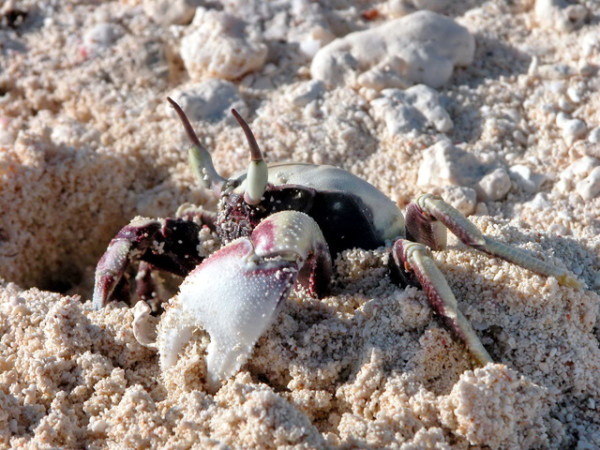Published in the Ocean Watch column, Honolulu Star-Advertiser © Susan Scott
February 8, 2016
While walking a beach at Midway recently, I noticed a lot of ghost crab holes with flat smooth sand around them, no mounds, sprinklings or claw prints in sight. Ghost crabs (also called sand crabs) are famous for building large, complex burrows. So what, I wondered, had these crabs done with their sand?
 The horn-eyed ghost crab, the larger of Hawaii’s two
The horn-eyed ghost crab, the larger of Hawaii’s two
species of ghost crabs, is known to dig M-shaped burrows.
©2016 Susan Scott
You can see ghost crab holes on nearly every tropical, subtropical and temperate beach on the planet. But good luck seeing the holes’ architects. The world’s 22 ghost crab species make their mansions mostly at night and hunker down in them during the day. Ghost crabs use their burrows the way we use houses. The dwellings provide refuge from predators and bad weather, are a private place to change clothes (in the crab’s case, to molt), and when the time is right, they’re love shacks. A crab hole generally has a funnel shape at the top leading to a tunnel that ends in a chamber. Depending on species, ghost crab burrows look like the letters Y, J, I and U. The larger of Hawaii’s two species, the horn-eyed ghost crab, sometimes digs M-shaped burrows. This is usually the result of a new resident re-excavating an abandoned burrow.
The side branches of Y and M shapes are either escape routes or places to hide from predators that dig, such as coyotes, foxes, mongooses and dogs. How deep a crab’s tunnel goes depends on the sand’s moisture. The drier the sand, the deeper the burrow, because ghost crabs have lungs and gills that both need water to absorb oxygen. When we see ghost crabs taking dips in the surf zone, they’re wetting their breathing organs.
Here in the main islands, ghost crabs often leave evidence of their quarries, either throwing excavated sand willy-nilly or piling it in mounds. During the reproductive season, Hawaii’s horn-eyed males build copulation burrows in an S shape. To advertise their bachelor pads to females, males shape their scooped-out sand into pyramids.
Scattered sand, mounds and pyramids, however, are like arrows directing predators to a crab’s location. And that’s where those Midway crabs’ holes with no tailings make sense. To mask their whereabouts, ghost crabs sometimes trample their excavated sand, expertly erasing all traces of digging.
In addition to eating dead plant and animal material that washes up, ghost crabs are ecosystem engineers. Their burrows create passageways for air and water to mix sand, bacteria, soil and sediment, crucial factors in maintaining healthy beaches.
Besides being useful, ghost crabs are fun to watch and beautiful to behold. Please be kind to these native species. Our beaches need them.